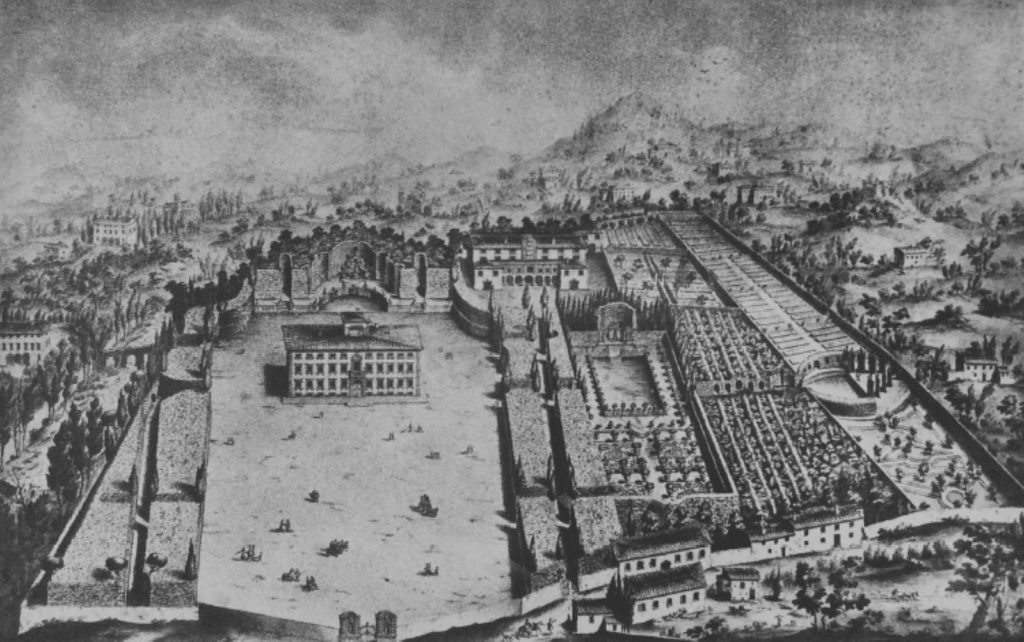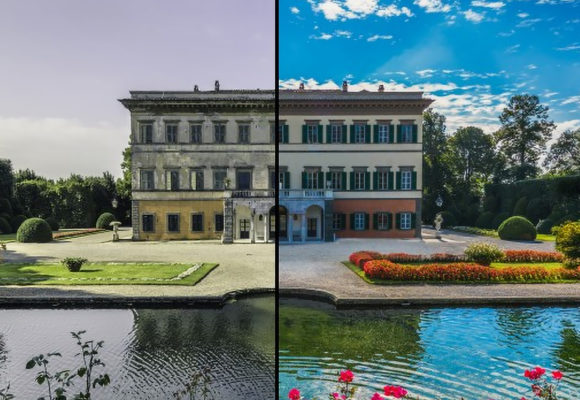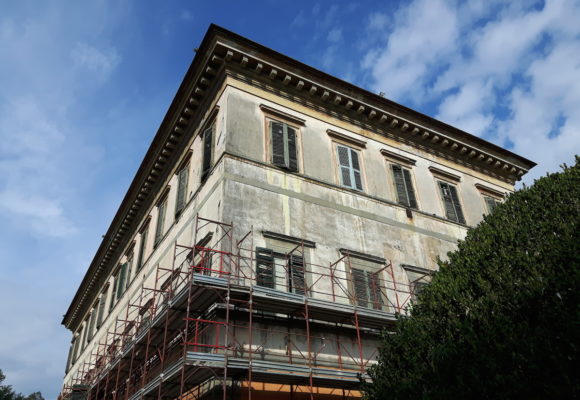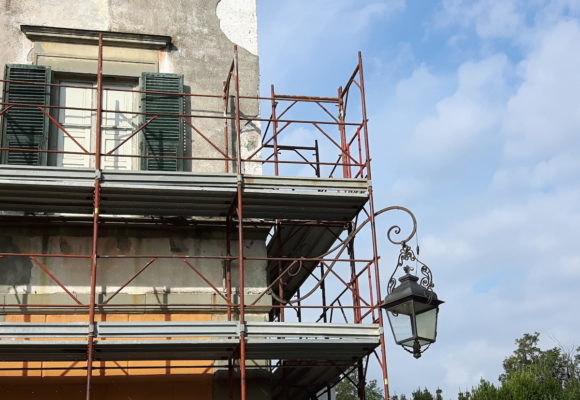A visit to Villa Reale and the Park is a chance to immerse yourself in a historic setting with roots stretching back to the Medieval age, which the initial construction of the estate dates back to. The buildings and their decorative elements, and the Park itself (with its wide variety of gardens and architecture you can enjoy today) are the results of a series of transformations launched over the centuries by illustrious figures and royal dynasties.
The Origins of the Villa
The first ‘nucleus’ of the Lucca Villa consisted of a fortress inhabited by the Duke of Tuscia. The property subsequently passed to noble families of bankers and merchants from Lucca, who transformed the fortress into a distinguished building. After the downfall of the Buonvisi family, the vast majority of their assets were put up for sale.
The historic residence was bought by Olivieri and Lelio Orsetti in 1651, who carried out modifications to the Villa and recreated the Park in a baroque style with the creation of avenues and spectacular gardens still in existence today, including the Green Theatre and the Lemon Garden. During the 18th century, the two noblemen also constructed the elegant Clock House with its distinctive loggia.
The Napoleonic Era
In 1806 Elisa Bonaparte Baciocchi, Napoleon’s sister and Princess of Lucca, bought the property. The Princess had a strong bond with the residence in Marlia, proceeding with major works which transformed the structure of the building and the gardens. Shortly after the purchase, the Princess incorporated the Bishop’s Villa into the estate, whose garden includes the 16th century Nymphaeum and its richly decorated Pan’s Grotto. She also modernised the façade of the the ancient Orsetti building in a neoclassical style, in addition to commissioning empire style decoration for the interiors, visible today after large-scale restoration work.
The model that Elisa adopted for renovation work was that of Malmaison, the private residence of Napoleon and Josephine near Paris. The Park was also partially redesigned in line with the fashion for English gardens – a rare occurrence in Italy, so much so that the Austrian Prince of Metternich enthusiastically praised it, writing that he had never seen a similar English-style Park in the country with such a wide variety of plants. His comments attest to the vitality of court life, enriched by important artists like Niccolò Paganini. Jean Racine’s drama Phèdre was premiered at Marlia, in the Green Theatre.
The most significant change to the historic Villa was the distinctive landscaping in front of the main Villa building – a downward slope which draws the eye and gives movement to the view, in line with the romantic style of Elisa’s time. New species were introduced to the Park, including the beautiful camellias which adorn two large walkways, as well as new statues and pots in precious white Carrara marble.
The Bourbon Dynasty
Elisa had to leave the kingdom in February 1814, after the fall of Napoleon. The Princedom of Lucca was transformed into the Duchy, assigned to Carlo Ludovico of Bourbon. Villa Reale then became the summer residence of the new court, who delighted in organising splendid dances, often hosting distinguished individuals, noblemen and royalty.
In the second half of the 1800s, the estate witnessed a period of tribulation and painful changes of ownership. Vittorio Emanuele II, the King of Italy, decided to transfer the estate to Penelope Carolina, the widow of Carlo of Bourbon, Prince of Capua.
When she died in 1882, the estate was passed to the two children, Vittoria Augusta and Francesco Carlo, whose mental illness earned him the name “The Mad Prince”. When his sister Vittoria died, the Prince, ravaged by debt, was aided by a guardian who dealt with the management of the family property. The Villa Reale estate was put up for sale. Many items of furniture were sold at auction, and many trees within the Park were cut down for timber.
Villa Reale from the 1900s until the Present Day
The Count and Countess Pecci-Blunt bought the estate in 1923. The next year they commissioned the famous French architect Jacques Greber for the restoration of the Park and gardens, with the aim of uniting tradition and innovation. Woodland, streams, a lake, and other bucolic features were created to complete and enrich the existing romantic picture created by the classic Italian gardens.
An eclectic range of features (still in existence and under restoration today) were added to the Park, such as the Games Pavilion (currently housing a café open to the public), and an area for sport. This area featured a Swimming Pool, which remains one of the most fascinating areas of the Park. The Pool has unusual Liberty style changing rooms, a wooden diving board and is distinctive for its bright colours. It had a powerful heating system for the water, which is still in existence.
A full restoration is planned for the Swimming Pool. Many illustrious individuals whiled away carefree days here at the Pool, including the painter Salvador Dalì and the writer Alberto Moravia (who also enjoyed playing croquet). Numerous important people were hosted by the Pecci Blunts, who spent the summer months at the Villa. Thanks in grand part to Anna Laetitia (known as Mimì), who was a great patron of the arts with an eye for talent, Villa Reale experienced a period of lively cultural activity, with guests including Jean Cocteau, Paul Valery and the painter Afro, just to name a few. Mimì’s fashionable salon attracted members of the international nobility and jet-set, including Jacqueline Kennedy and the Duke and Duchess of Windsor.
In 2015, the neglected estate was sold to the current owners, Henric and Marina Grönberg, who fell in love with the Villa and took on the challenge of bringing it back to its former glory and opening it to the public for the first time, so that its many hidden treasures could be enjoyed by everyone. They immediately commissioned extensive restoration works to the buildings and the Park, rendered even more challenging by unforeseen events – shortly after purchasing the Villa a terrible storm brought down many ancient trees, making work on the parkland more complicated. Despite the setback works continued (and continue today), with the same scrupulous care and attention.
The result of this work has brought one of the most beautiful Villas to visit in the Province of Lucca back to life.



